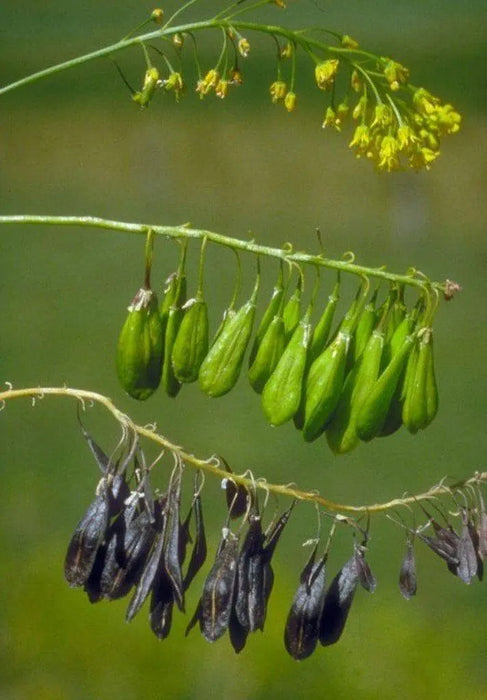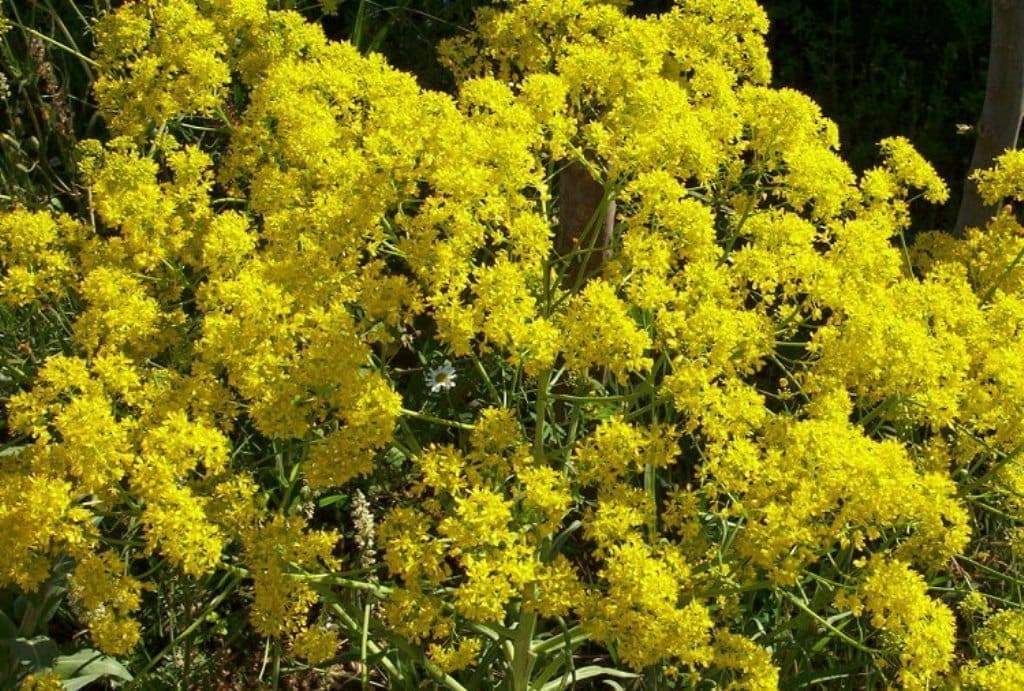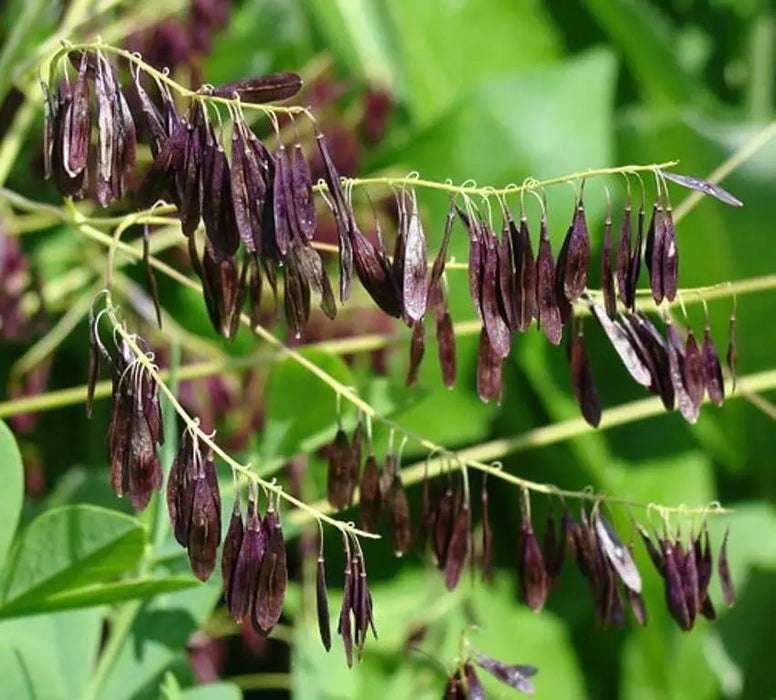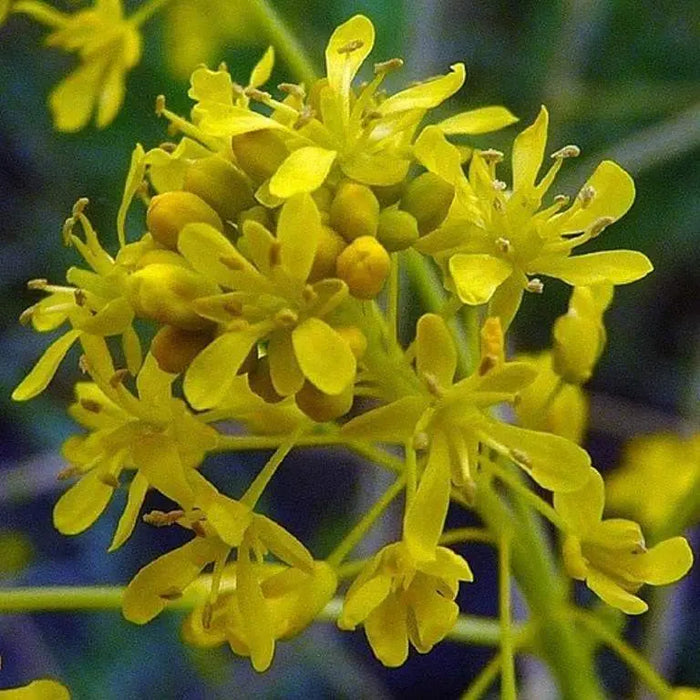
Dyer's woad Seeds, satis tinctoria,asp of jerusalem,traditional Chinese medicine
Original price
$ 2.15
-
Original price
$ 21.95
Original price
$ 2.15
$ 2.15
-
$ 21.95
Current price
$ 2.15
Most orders are processed by the next day
Select your desired size and/or color from the available options.
dyer's woad Seeds,Isatis tinctoria,asp of jerusalem ,traditional Chinese medicine.
Isatis tinctoria Seeds.
Dyers Woad
Wildflower of Britain and Ireland
Isatis is a genus of plants that are grown as hardy bulbs in the garden.Isatis blooms in the summer with small yellow panicles and may reach a height of 30 to 90 cm in height.Some of the common names for Isatis are Woad and Dyer's woad. It has been traditionally used to produce dye and paint.
This European native and ancient crop has a long and complex history, Woad has recently captured popular imagination as producing the blue dye for body paint used by the Celts.
It is found in many parts of Great Britain, but not fully naturalized, except near Tewkesbury, where, it appears to be indigenous.
This fashionable plant has a fresh wildflower appearance that can brighten any garden. As a biennial it grows one year, flowers and produces seed the second year and dies. The seedlings develop rosettes that produce large taproots during the first year. The following spring, new leaves grow from the crown bud in the rosette, and flowering begins with the exact timing dependent upon elevation.
The crop initially looks similar to spinach but later, with its bright yellow flower, it looks much like oilseed rape in the field. The top of each stalk is branched with many yellow flowers which turn into large, flat, blue-black, decorative seed heads.
Woad has been grown for its indigo-blue pigment in Britain and throughout Europe since the Stone Age and cultivated for its medicinal properties since the 13th century.
It has now been almost superseded by imported indigo from South East Asia and with synthetic dyes. It is currently cultivated to a small extent in Lincolnshire, in the south of France and in Flanders.
Sowing:
Sow in late winter/late spring or late summer/autumn.
Woad seed has a germination inhibiting chemical that is water soluble. It is washed into the soil by rain. This allows the seed to remain dormant for long periods waiting the ideal moisture conditions for optimal growth. It also inhibits the growth of other plants that may compete with the woad. When beginning woad seed indoors it may be helpful to soak the seed overnight to remove this germination inhibitor.
Sown the seed, thinly spaced, in shallow drills directly outdoors or in seed trays. Lightly cover with soil and water well. Easy to grow, Woad germinates in 1 to 2 weeks. Thin or transplant seedlings 30cm (12in) apart when they are large enough to handle.
Cultivation:
Woad plants like an alkaline soil, so apply lime to the soil about a week before transplanting. For use as a dye - for dark colours woad needs plenty of nitrogen, which it can get from fertilisers such as dried blood & bone meal or hoof & horn meal.
Like other plants of the cabbage family, woad plants are susceptible to club root. Rotate annually and do not plant where other brassicas have been grown. Hardy to -15°C (5°F)
It will take 20 months to flower. The leaves are harvested when fully grown and 3 - 4 harvests can be made in total
Plants self-sow freely when they are grown in a suitable position, though they tend not to thrive if grown in the same position for more than two years. To prevent woad from self seeding cut back all but one or two flower stalks and the remaining flowers will provide all the seeds you need for the next season.
Harvesting:
Cut leaves from first year woad plants with secateurs. Woad planted in November can be harvested from end of June till early August. Planted in March it can be harvested from July until September. First frosts may destroy the colour although some people manage to get colour all the year round.
Use as a Dye:
Clothes dyed with woad indigo at first appear yellow, but as they dry they turn green, then turquoise then finally deep blue. Often used alongside Madder, Weld and Chamomile, together with Woad, they are the very best natural dyes for temperate areas. Madder makes shades of red, Weld and Chamomile yields a bright yellow, and Woad gives blues. (Indigotin is the blue dye, whether you get it from woad- Isatis tinctoria, Indigofera tinctoria, or some other source.).
They are all quite colourfast and produce excellent quality dyes that are used amongst artists etc who want to work with natural dyes. Woad mills are still worked at Wisbech, but not for the dye itself, the produce also improve the quality, colour and fixes true indigo, and is also used to form a base, or mordant, for a black dye.
In commercial use, for a typical year, an acre of woad yields around 1kg of pigment and costs around £400 to produce compared to just £2.75 for a synthetic equivalent.
Although woad has not been grown commercially since the 16th century, it was produced in Lincolnshire during the 1920s and 1930s to provide dye for Royal Air Force uniforms, before the adoption of synthetic colourings. It has also been grown occasionally by artisan weavers and spinners for their own use.
Medicinal Uses:
Woad's medicinal uses have been known as far back as the late 1500s in traditional Chinese medicine. It is an astringent plant known for reducing fever and inflammation and is reported to have antiviral properties. The parts of the plant used in natural medicine are the leaves, roots, and pigment.
Other Uses:
Woad was also used as a natural insecticide. It is currently being grown commercially on a small scale in Germany as a wood preservative. (An item on BBC's Radio 4 Farming Programme).
Origin:
Woad is native to the steppe and desert zones of the Caucasus, Central Asia to eastern Siberia and Western Asia, but is now also found in southeastern and some parts of Central Europe. It has been cultivated throughout Europe, especially in Western and southern Europe since ancient times.
Pliny, the Roman historian, described how the ancient Britons 'blue aspect made them look more fearsome' - their appearance created either by applying woad body paint, or tattoos etched in woad.
In the 1995 film Braveheart, William Wallace, played by Mel Gibson, wears woad in the battle scenes to dramatic effect, but this is probably an anachronism, as the dye was no longer in use.
The blue threads in the Bayeux Tapestry were dyed using woad and the blue in the tapestry is the only colour not to have faded in more than 900 years.
Materials: Hardy,plant,Healthy,medicinal herb,Isatis tinctoria,asp of jerusalem,traditional Chinese medicine,dyers woad Seeds,Wildflower of Britain and Ireland Select your desired size and color from the available option
Isatis tinctoria Seeds.
Dyers Woad
Wildflower of Britain and Ireland
Isatis is a genus of plants that are grown as hardy bulbs in the garden.Isatis blooms in the summer with small yellow panicles and may reach a height of 30 to 90 cm in height.Some of the common names for Isatis are Woad and Dyer's woad. It has been traditionally used to produce dye and paint.
This European native and ancient crop has a long and complex history, Woad has recently captured popular imagination as producing the blue dye for body paint used by the Celts.
It is found in many parts of Great Britain, but not fully naturalized, except near Tewkesbury, where, it appears to be indigenous.
This fashionable plant has a fresh wildflower appearance that can brighten any garden. As a biennial it grows one year, flowers and produces seed the second year and dies. The seedlings develop rosettes that produce large taproots during the first year. The following spring, new leaves grow from the crown bud in the rosette, and flowering begins with the exact timing dependent upon elevation.
The crop initially looks similar to spinach but later, with its bright yellow flower, it looks much like oilseed rape in the field. The top of each stalk is branched with many yellow flowers which turn into large, flat, blue-black, decorative seed heads.
Woad has been grown for its indigo-blue pigment in Britain and throughout Europe since the Stone Age and cultivated for its medicinal properties since the 13th century.
It has now been almost superseded by imported indigo from South East Asia and with synthetic dyes. It is currently cultivated to a small extent in Lincolnshire, in the south of France and in Flanders.
Sowing:
Sow in late winter/late spring or late summer/autumn.
Woad seed has a germination inhibiting chemical that is water soluble. It is washed into the soil by rain. This allows the seed to remain dormant for long periods waiting the ideal moisture conditions for optimal growth. It also inhibits the growth of other plants that may compete with the woad. When beginning woad seed indoors it may be helpful to soak the seed overnight to remove this germination inhibitor.
Sown the seed, thinly spaced, in shallow drills directly outdoors or in seed trays. Lightly cover with soil and water well. Easy to grow, Woad germinates in 1 to 2 weeks. Thin or transplant seedlings 30cm (12in) apart when they are large enough to handle.
Cultivation:
Woad plants like an alkaline soil, so apply lime to the soil about a week before transplanting. For use as a dye - for dark colours woad needs plenty of nitrogen, which it can get from fertilisers such as dried blood & bone meal or hoof & horn meal.
Like other plants of the cabbage family, woad plants are susceptible to club root. Rotate annually and do not plant where other brassicas have been grown. Hardy to -15°C (5°F)
It will take 20 months to flower. The leaves are harvested when fully grown and 3 - 4 harvests can be made in total
Plants self-sow freely when they are grown in a suitable position, though they tend not to thrive if grown in the same position for more than two years. To prevent woad from self seeding cut back all but one or two flower stalks and the remaining flowers will provide all the seeds you need for the next season.
Harvesting:
Cut leaves from first year woad plants with secateurs. Woad planted in November can be harvested from end of June till early August. Planted in March it can be harvested from July until September. First frosts may destroy the colour although some people manage to get colour all the year round.
Use as a Dye:
Clothes dyed with woad indigo at first appear yellow, but as they dry they turn green, then turquoise then finally deep blue. Often used alongside Madder, Weld and Chamomile, together with Woad, they are the very best natural dyes for temperate areas. Madder makes shades of red, Weld and Chamomile yields a bright yellow, and Woad gives blues. (Indigotin is the blue dye, whether you get it from woad- Isatis tinctoria, Indigofera tinctoria, or some other source.).
They are all quite colourfast and produce excellent quality dyes that are used amongst artists etc who want to work with natural dyes. Woad mills are still worked at Wisbech, but not for the dye itself, the produce also improve the quality, colour and fixes true indigo, and is also used to form a base, or mordant, for a black dye.
In commercial use, for a typical year, an acre of woad yields around 1kg of pigment and costs around £400 to produce compared to just £2.75 for a synthetic equivalent.
Although woad has not been grown commercially since the 16th century, it was produced in Lincolnshire during the 1920s and 1930s to provide dye for Royal Air Force uniforms, before the adoption of synthetic colourings. It has also been grown occasionally by artisan weavers and spinners for their own use.
Medicinal Uses:
Woad's medicinal uses have been known as far back as the late 1500s in traditional Chinese medicine. It is an astringent plant known for reducing fever and inflammation and is reported to have antiviral properties. The parts of the plant used in natural medicine are the leaves, roots, and pigment.
Other Uses:
Woad was also used as a natural insecticide. It is currently being grown commercially on a small scale in Germany as a wood preservative. (An item on BBC's Radio 4 Farming Programme).
Origin:
Woad is native to the steppe and desert zones of the Caucasus, Central Asia to eastern Siberia and Western Asia, but is now also found in southeastern and some parts of Central Europe. It has been cultivated throughout Europe, especially in Western and southern Europe since ancient times.
Pliny, the Roman historian, described how the ancient Britons 'blue aspect made them look more fearsome' - their appearance created either by applying woad body paint, or tattoos etched in woad.
In the 1995 film Braveheart, William Wallace, played by Mel Gibson, wears woad in the battle scenes to dramatic effect, but this is probably an anachronism, as the dye was no longer in use.
The blue threads in the Bayeux Tapestry were dyed using woad and the blue in the tapestry is the only colour not to have faded in more than 900 years.
Materials: Hardy,plant,Healthy,medicinal herb,Isatis tinctoria,asp of jerusalem,traditional Chinese medicine,dyers woad Seeds,Wildflower of Britain and Ireland Select your desired size and color from the available option
LET OUR CUSTOMER SPEAK FOR US

![[Seeds] - Caribbeangardenseed](http://caribbeangardenseed.com/cdn/shop/files/gift-card-gift-card-1_1024x1024_dfa857db-9150-4315-a362-7f0bb3fb9c47_60x28.png?v=1703978838)



